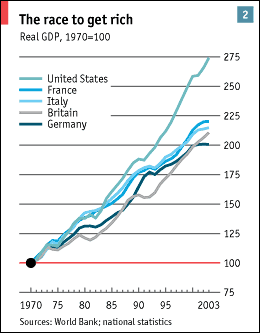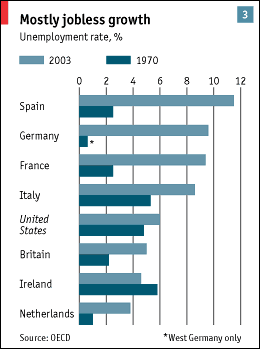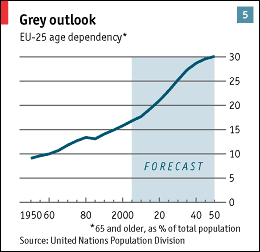|
|
||||||
| |
 | |
A mature perspective |
WHAT do ordinary Europeans want from the European Union? The opinion polls provide an unambiguous answer: jobs. The heart of the Union is plagued by high unemployment. In the euro area—the 12 countries that have adopted the single currency—average unemployment is 9% of the workforce. European leaders may be preoccupied with high-minded tasks such as enlargement or drafting a constitution, but the voters' main concern is their livelihood. The early years of European integration were helped by rapid and sustained economic growth in western Europe, but recently growth has become slow and intermittent. This is undermining one of the chief arguments for European unity: a reasonable expectation of ever-growing prosperity.
In the 30 years from 1945 to 1975, west European countries that had been devastated by war rebounded with astonishing speed. From 1950 to 1960, German GDP grew at an average of 7.9% a year. The number of private cars in France and Germany increased 20-fold between 1950 and 1966. The spread of affluence and the rise of the consumer society became a familiar story across the western world, but growth in western Europe was even faster than in the United States. Average income in western Europe rose from about 40% of American levels in 1950 to just over 70% by 1973.
Exactly how much of western Europe's economic development can be attributed to the merging of markets and the dismantling of tariff barriers that formed part of the drive for European unity is a moot point. Many economists think the EU has played a crucial role by creating a secure legal environment for business and enabling European companies to reap the economies of scale previously available only in the United States. On the other hand, it is striking that by the time the common market was established, almost half the miracle years of 1945-75 had already passed. Nonetheless, countries that had stood aside from the European experiment were soon casting envious glances at the economic success of the participants.
In his valedictory dispatch in 1979, Sir Nico Henderson, Britain's ambassador to France, pointed out that in 1954 Britain's GDP per person had been well ahead of France's and West Germany's, but by 1977 it had fallen 41% and 46% respectively behind those of its big neighbours. Sir Nico attributed much of this relative decline to Britain's lack of enthusiasm for the process of European integration.
Britain did not join what was then the European Economic Community until 1973, along with Ireland and Denmark. Since then successive waves of enlargement carried the hopes of poorer European countries to achieve the wealth levels of “core Europe”.
 | |
For many new EU members, entry has indeed triggered rapid economic growth. The biggest success story is that of Ireland, where income per person was only 62% of the EEC average when it joined in 1973, but had reached 121% of the EU average by 2002. However, other late entrants have also done well. Spain, a much larger country, has emerged from the poverty and isolation of the Franco era and is now one of the fastest-growing and most dynamic countries in Europe. The eight central European countries that joined the EU this year have high hopes that membership of the Union will work its magic for them too.
But whereas some peripheral European economies boomed after joining, the core European economies that they sought to emulate began to stagnate. In Germany, France and Italy, the heart of the single-currency area, unemployment is now hovering around 10% and public finances are in a mess. Germany in particular has had a grim few years: since 1996, it has averaged growth of just 1.3% a year. In fact, western Europe's economic miracle ended a long time ago. Average income levels, having risen to 70% of America's in the early 1970s, have been stuck there ever since and are now declining in relative terms.
Efforts to re-launch the EU economy through bold reforms have mostly proved disappointing. The Single European Act, passed in 1986, was meant to light a bonfire of trade-restricting regulation and create a true single European market by 1992. The euro became a reality in 2002, launched in the hope that a single currency would spur trade, competition and ultimately growth. Yet neither the single market nor the single currency have yet fulfilled these hopes.
European policymakers are feeling glum. Guy Verhofstadt, the Belgian prime minister, recently summed up their mood: “Growth in Europe last year was 0.8%, in the United States it was over 3%, in China it was over 10%...If we don't change things, we risk turning Europe into a social and economic museum.” A senior EU economic policymaker, noting that America's productivity has once again begun to surge ahead of Europe's, muses: “Europe urgently needs to press ahead with structural reforms. It is unsustainable, year after year, to fall behind in GDP per head because you do not improve labour productivity.”
 | |
But are things really that bad? Some observers think that the sense of gloom in Europe is exaggerated. The Asian tigers may be growing much faster than the European economies, but then they started off far poorer. And much of the faster growth in the United States simply reflects the country's rapid increase in population: productivity per worker is actually fairly similar to that in the EU. Any remaining gap between Europe's and America's economic performance in recent years is due largely to problems in Germany, which is still trying to recover from the economic effects of unification. By contrast, some of the more peripheral European countries have done strikingly well. The World Economic Forum last year rated Finland as the world's most competitive economy, with Sweden coming third.
Perhaps, too, most Europeans have simply decided to enjoy some of their wealth in the form of leisure, rather than working ever longer hours, as the Americans do. Their economies may be growing more slowly, but their lives may be pleasanter. However, this theory of a European “preference for leisure” is controversial. Some experts believe that Europeans work less because they genuinely prefer to take time off; others argue that it is high taxes that discourage people from working and creating jobs.
But this beauty contest between the American and European models is ultimately beside the point. Miss Europe and Miss America may each have their admirers, but Miss Europe is at a huge disadvantage because she is growing old far more rapidly. Because Europe's society is ageing, the EU's real economic problems are yet to come. Suppose, for the sake of argument, that Europeans collectively have indeed made a choice to accept lower economic growth in return for more social protection and leisure time—the so-called “European social model”. The trouble with this model is not that it is illegitimate, but that it is unsustainable.
At present, the EU has 35 people of pensionable age for every 100 of working age. But Europeans are not having enough children to replace today's workers. A Deutsche Bank report in 2002 calculated that, on current demographic trends, by 2050 there will be 75 pensioners for every 100 workers in the EU. More immigration might ease the problem, but the numbers needed to offset the effect of ageing would probably be politically unacceptable.
State pensions in the EU are mostly paid for out of current tax revenues, so either taxes or national debts, or both, may have to rise steeply. In a recent report on the fiscal implications of ageing in Europe, Standard & Poor's, a credit-rating agency, predicts that the EU countries with the most serious pensions problems—including France and Germany—could see their public debt grow to more than 200% of GDP by 2050. For comparison, countries that want to join the euro are supposed to keep their public debt below 60% of GDP.
 | |
EU policymakers realise that something has to give. According to an authoritative report commissioned by the EU and led by André Sapir, an economics professor at the Free University of Brussels, “The current combination of low growth and high public expenditure is not sustainable and will become less so in the future.” As the Sapir report makes clear, the major European economies have become locked into a vicious circle: low growth has led to higher unemployment, which has led to higher social expenditure, which has led to higher taxes and thus to lower growth. It states bleakly that: “The sustainability of the European model(s) of development is increasingly challenged, without a viable alternative in view.”
The EU's demographic problem is worsened by the number of working-age Europeans relying on welfare. The unemployment statistics of 9-10% in the euro zone are just the tip of the problem. Much larger numbers of potentially working-age people are not at work but are drawing some sort of welfare benefit, perhaps because they are single mothers or are classified as disabled or have retired early. In the Netherlands, for example, around 1m out of a working-age population of less than 9m are now classified disabled, many with psychological ailments.
Raymond Torres of the OECD, an economic think-tank, reckons that around 40% of Europeans of working age are economically inactive, compared with 29% of Americans. He says that Europeans must get more people back to work, both by raising the pension age and by reducing welfare rolls. The alternative is that “welfare systems will collapse and there will be a forced and chaotic reduction of benefits.”
There is hope that it may not come to that. Already calls for structural economic reforms have become a staple of European politics, and even some of the trade unions are becoming more realistic. Big German employers such as Bosch, Siemens and DaimlerChrysler have recently negotiated agreements to extend working hours without increasing pay, which should sharply increase productivity. The enlargement of the EU, and the knowledge that just across the border there are workers willing to do the job for far less money, has clearly acted as a spur to reform.
Some European governments have introduced successful policies for getting the unemployed back to work. In Britain and Denmark the ratio of the population at work is higher than in America. Such successes have spurred other European governments to try harder. Gerhard Schröder, the German chancellor, has pushed through a package of reforms, including the first cuts in the level of unemployment benefits in Germany since 1945.
But reform remains fearsomely difficult. Mr Schröder's reward has been to see his party slump in recent regional elections, and to be told by economists that his efforts are inadequate. The political climate elsewhere is equally discouraging. In Italy, the government of Silvio Berlusconi recently had to call a vote of confidence to force through a reform to raise the country's retirement age. In France, nobody has attempted a bold pension reform since the government of Alain Juppé was fatally damaged by street demonstrations in 1995. The memory still lingers.
But however menacing the demographic time-bomb may be for Europe, is it really a problem for the EU? After all, welfare and pensions are still run by national governments, not by the EU—and it is those governments that will be punished at the ballot box if things go wrong.
 | |
All the same, the EU is unlikely to escape the consequences. It has deliberately tied together its members' political and economic fates. Twelve EU countries now share a currency, and all 25 members are linked by a dense network of economic and social policies. If economic problems mount, so will political tensions among EU members.
These tensions could be most serious inside the euro zone (see article), but some consequences of a deteriorating economic climate will be equally felt by all EU members. In particular, this is likely to affect the direction of economic policy. Over the past few decades, EU countries have united behind big joint projects such as the creation of the internal market. But different countries have interpreted the “single market” in different ways.
The British complain that it has been introduced with too much Brussels-inspired regulation attached to it, and call for further and faster market-opening and less red tape. The French grumble that the internal-market programme has promoted “liberal Europe” at the expense of “social Europe”. They want to redress the balance by introducing more Europe-wide social legislation on such things as workers' rights and minimum wages. The Germans, for their part, fret that zealots in the European Commission have been hurting German industry, and are campaigning for less onerous environmental legislation and a more relaxed attitude to state subsidies. A new element has been added by the arrival of the new central European members, who are anxious to preserve their competitive advantages: low wages, low taxes and light regulation.
Historically, the genius of the European Union has been that it has managed to accommodate and contain such different traditions and priorities. But things could soon get much more difficult. Enlargement has greatly added to the diversity of the EU. How do you design rules that make as much sense in Sweden as they do in Slovakia? One answer would be simply not to try. But the EU has a terrier-like record of never retreating from any policy area that has become part of the acquis communautaire, the body of laws, rules and regulations agreed on by the member countries.
The clash between the different political philosophies within the EU could also become sharper in the next few years. The French and the Germans, for example, have made it clear that they would like the EU to do more to develop a pan-European “industrial policy”. Yet that would be anathema to the market-based policies on competition and state aid that have in recent years been pushed by Britain and indeed by the European Commission itself.
When economic times are hard, such problems become more difficult to gloss over. In the past, with a prosperous Germany at the heart of a self-confident Union, many tough problems were eventually resolved by the German government reaching for its cheque book. In the 1960s, as European integration got going, the Germans agreed to the common agricultural policy, a baroque system of farm subsidies that has always benefited France disproportionately, almost as a form of war reparations. In the 1980s, when Spain and Greece hesitated to agree to the single market because they feared their industries could not cope with the competition, huge EU regional-aid programmes, again underwritten by Germany, smoothed the way.
But modern Germany is no longer willing or able to be this generous. Other traditional big payers such as the Dutch are also in a much meaner mood. The next EU budget round, which starts in earnest later this year, will be extremely tricky.
The real risk, however, will not be that EU negotiations become harder. It will be that European citizens, facing difficult economic times and the erosion of their much-loved “European social model”, decide to put some of the blame on the Union itself. The opinion polls already make troubling reading. The latest Eurobarometer polls, taken in the 15 countries that made up the EU before enlargement, asks, “What does the EU mean to you personally?” Although the EU's most far-reaching powers are over the economy, “prosperity” came way down the list, cited by 19% of respondents; more (26%) said the Union was a “waste of money”.
On the main economic issues facing the EU—fighting unemployment, containing inflation and protecting pensions—those that give it good marks are outnumbered by the critics. The strains of reforming the “European social model” could exacerbate what is perhaps the EU's most profound problem: the lack of genuine popular support for “ever closer union”.
|
Copyright © 2004 The Economist Newspaper and The Economist Group. All rights reserved. |